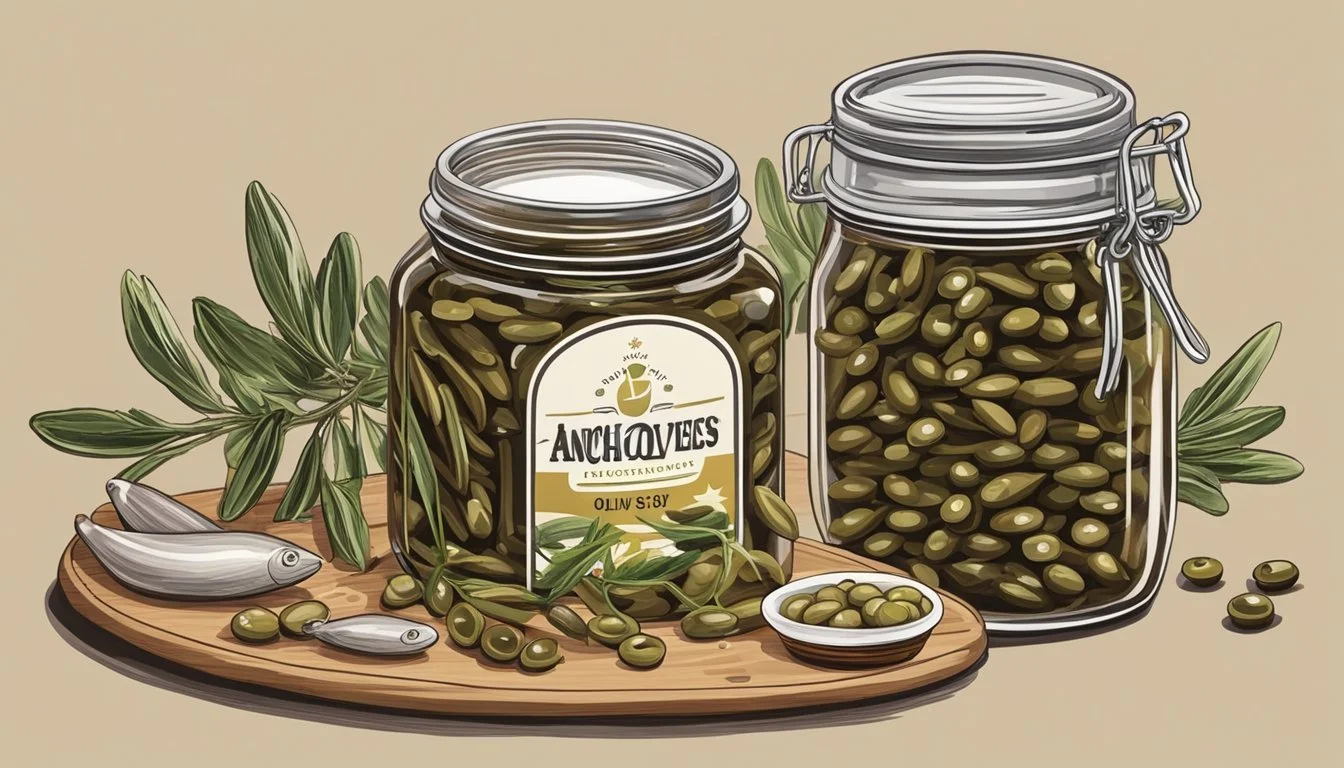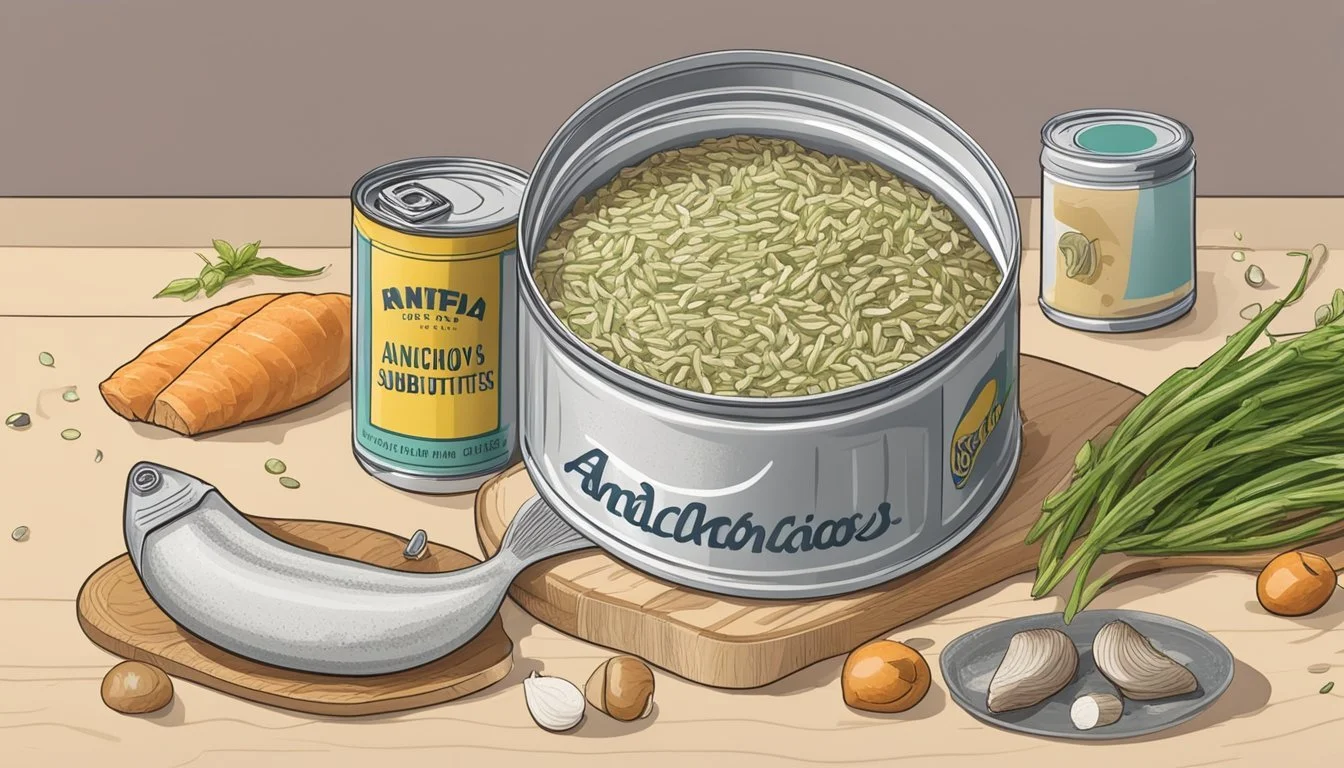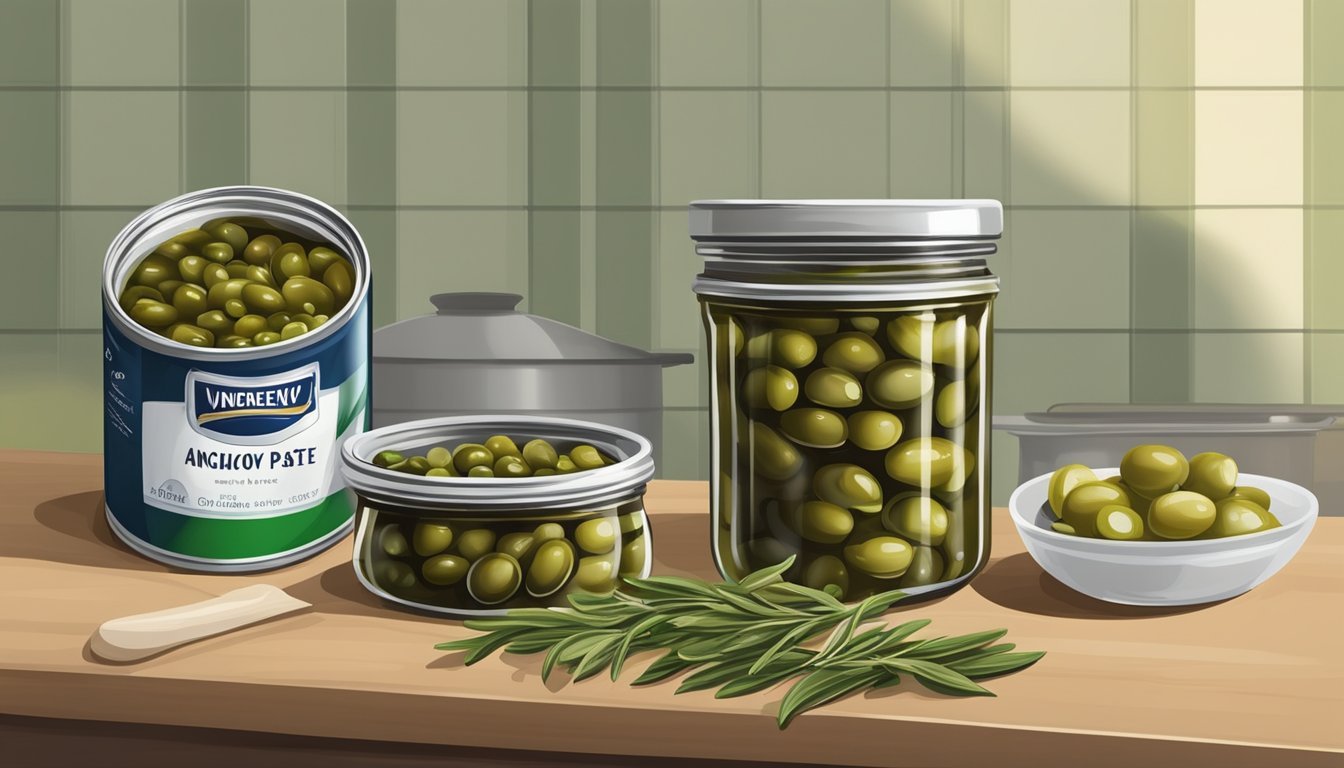Anchovies Substitutes
Best Alternatives for Great Flavor
Finding the perfect substitute for anchovies can be essential for those looking to maintain the distinct umami flavor while accommodating dietary restrictions or personal preferences. Anchovies, known for their intense salty and savory profile, can be replaced with various alternatives that deliver similar savory notes and saltiness. Top choices include miso paste, which provides a comparable level of saltiness and the right texture, and yeast extracts like Marmite or Vegemite, excellent vegan options.
Soy sauce and fish sauce are also great non-vegan substitutes, bringing a similar depth of flavor to dishes such as sauces, dressings, and soups. For those seeking plant-based alternatives, capers offer a briny taste that can mimic the unique profile of anchovies. Sardines can also serve as a substitute, especially in recipes where the presence of small fish is not a defining characteristic but the flavor is what counts.
Understanding Anchovies
Anchovies are small, saltwater fish known for their distinct salty and umami-rich flavor. They are a key ingredient in various dishes, offering nutritional benefits such as high Omega-3 fatty acids, calcium, and protein.
Flavor Characteristics
Anchovies possess a unique flavor profile that combines salty and umami notes. Their taste is often described as intensely savory, with a slight fishiness that can be both bold and nuanced. This flavor makes them highly versatile in enhancing the taste of different dishes.
Due to their strong flavor, a little goes a long way. The umami element in anchovies boosts the overall savoriness of meals, making them indispensable in certain culinary traditions.
Common Uses in Cooking
Anchovies are a key ingredient in a variety of iconic dishes. Caesar salad uses anchovies in its dressing to create a rich, savory flavor. Puttanesca sauce for pasta features anchovies, capers, and olives, adding depth to the dish.
They are also commonly used in stews and pizza toppings, especially in Mediterranean cuisine. In addition, anchovies can be found in sauces like Worcestershire, which relies on their powerful umami profile to enhance its taste.
Nutritional Profile
Anchovies are not just flavorful; they are also packed with nutritional benefits. They are an excellent source of Omega-3 fatty acids, which are essential for heart health. A serving of anchovies provides a significant amount of protein, contributing to muscle repair and growth.
Rich in calcium and iron, anchovies help in maintaining healthy bones and efficient oxygen transport in the blood. Their small size means they are consumed whole, ensuring that none of their nutrients go to waste.
Tables, lists, and emphasis on key ingredients can help readers quickly grasp the significance of anchovies in both flavor and nutrition.
Why Substitute Anchovies?
Substituting anchovies can be necessary for several reasons including dietary preferences, allergies, and simple availability issues. Below, each of these factors is examined to provide clarity on why alternatives might be sought.
Dietary Choices and Restrictions
People following vegetarian or vegan diets often look for substitutes. Anchovies are a source of animal protein and not suitable for those who avoid animal products. Seaweed and miso are common alternatives due to their umami flavor that can mimic anchovies in many dishes.
Additionally, certain diet plans may restrict anchovy consumption due to high sodium levels. People aiming to reduce sodium intake might opt for substitutes like low-sodium soy sauce or other plant-based options.
Allergies and Sensitivities
Some individuals have seafood allergies, making it essential to find substitutes. Anchovies can trigger allergic reactions in those sensitive to fish proteins. Symptoms range from mild (hives, itching) to severe (anaphylaxis).
To avoid allergens while maintaining flavor, options like Worcestershire sauce (ensure it's fish-free) or seaweed can be used. These provide similar taste profiles without risking allergic reactions.
Availability Issues
Anchovies might not always be readily available in every grocery store. Small, oily fish like anchovies are often found in specific types of markets, which can make them inaccessible to some.
Alternatives such as sardines, seaweed, or condiments like anchovy paste can be easier to find and store. These substitutes can ensure recipes are still flavorful and authentic even when anchovies are out of reach.
Salty and Savory Substitutes
Achieving the salty, umami flavor of anchovies can be done using various substitutes. These alternatives are particularly useful for those seeking vegan options or individuals with dietary restrictions.
Soy Sauce and Tamari
Soy Sauce and Tamari are excellent substitutes that provide a rich, umami flavor similar to that of anchovies. Soy sauce, a staple in many Asian cuisines, is created by fermenting soybeans and wheat. Its salty profile can elevate marinades, dressings, and dishes requiring depth.
Tamari, on the other hand, is often gluten-free and brewed without wheat, making it suitable for those with gluten sensitivities. Like soy sauce, tamari's fermentation process gives it a robust and savory taste, perfect for replacing anchovies in a variety of recipes.
Miso Paste and Marmite
Miso Paste is a fermented soybean paste that contributes a deep, umami flavor to dishes. It is available in various types, such as white, yellow, and red miso, each offering different levels of intensity. Miso is versatile and can enhance soups, dressings, and sauces with a complex, savory profile.
Marmite, a yeast extract spread, also delivers a powerful umami punch with its concentrated, salty taste. It's a convenient vegan alternative, providing the depth and savoriness needed in dishes traditionally enhanced by anchovies.
Worcestershire Sauce
Worcestershire Sauce is a fermented condiment containing a blend of vinegar, molasses, anchovies, garlic, tamarind extract, and other seasonings. Its complex flavor profile makes it a suitable substitute for anchovies, especially in recipes like Caesar dressing or savory sauces.
For those avoiding animal products, there are vegan Worcestershire sauces available. These versions replace the anchovy content with ingredients like soy sauce and spices, ensuring a similar tangy, umami-rich flavor without any fish-derived components.
Substitutes with Briny Notes
Some alternatives for anchovies bring that same briny, salty flavor but are suitable for different dietary needs or culinary preferences.
Capers and Olives
Capers and olives offer a briny flavor similar to anchovies. Capers, pickled in vinegar, provide a tart and salty taste. They can be used whole or chopped and work well in pasta sauces, salads, and tapenades.
Olives, especially Kalamata olives, have a robust, briny flavor. Sliced or chopped, they can substitute anchovies in recipes like pizzas, pasta dishes, and sauces. Mixing both capers and olives in a dish can enhance the complexity of the flavor.
Usage Tips:
Capers: Rough chop or use whole to infuse dishes with tangy, salty notes.
Olives: Use Kalamata olives for their briny depth, ideal for Mediterranean recipes.
Seaweed and Nori
Seaweed and nori are excellent substitutes, particularly for vegan options. They deliver a similar salty, umami kick. Common types are nori, wakame, and dulse. Nori sheets, commonly used in sushi, can be crumbled into soups, broths, and salads.
Other seaweeds like wakame and dulse are versatile and can substitute in broths or as garnishes. Nori has a mild taste and light salinity, while other seaweeds might offer stronger flavors.
Usage Tips:
Nori: Crumble sheets into small pieces to add to dishes.
Other Seaweeds: Rehydrate and use in soups or salads for a briny touch.
Fish-Based Alternatives
Fish-based alternatives for anchovies not only provide a similar savory flavor but are also high in protein and can be easily incorporated into various dishes. Key options include fish sauce and different small fish like sardines.
Fish Sauce and Asian Variants
Fish sauce is a staple in Southeast Asian cuisine, renowned for its powerful umami taste. Made from fermented fish, often anchovies or small fish, this sauce is rich in protein and brings a deep, savory flavor to dishes. Thai Nam Pla and Vietnamese Nuoc Mam are popular brands that can be used in place of anchovies.
The strong flavor of fish sauce means it should be used sparingly. Typically, 1 teaspoon of fish sauce can substitute for 2 anchovy fillets. Asian markets offer various fish sauce options reflecting regional tastes like Filipino Patis and Cambodian Prahok. Experimenting with these variants can add diverse dimensions to your recipes, making them valuable alternatives to anchovies.
Sardines and Other Small Fish
Sardines are an excellent substitute for anchovies due to their similar size and flavor profile. Canned sardines, readily available and convenient, can be used directly in many recipes. They are a rich source of protein and bring a robust, oily texture that mimics anchovies.
Other small fish like smelt or whitebait can also serve as replacements. These options are often found in the seafood section of grocery stores and can be prepared in various ways, including grilling or frying. Using sardines or other small fish can add depth and nutritional value to your dishes, making them a versatile and effective alternative to anchovies.
Vegan and Vegetarian Options
There are numerous vegan and vegetarian alternatives to anchovies that can impart similar umami and salty flavors. Key substitutes include mushroom and tomato pastes, as well as umeboshi paste and yeast extracts.
Mushroom and Tomato Pastes
Mushroom paste offers a rich, earthy flavor that can mimic some of the umami characteristics of anchovies. When dried mushrooms are rehydrated and blended, they create a concentrated paste that enhances various dishes.
Tomato paste is another excellent option. It brings acidity and sweetness, balancing flavors in recipes like vegan Caesar dressing. Combining both pastes can yield even deeper flavor profiles, making them versatile in soups, stews, and sauces.
Umeboshi Paste and Yeast Extracts
Umeboshi paste, made from pickled Japanese plums, provides tanginess and umami. It adds a savory depth to vegan dishes and is particularly good in salad dressings and marinades.
Yeast extracts such as Marmite and Vegemite are also powerful vegan options. They offer a salty, umami-rich punch, suitable for replacing anchovies in dips, spreads, and sauces. Always check labels to ensure they fit vegan standards.
These alternatives not only cater to vegan and vegetarian diets but also contribute unique flavors and health benefits, enriching culinary experiences.
Homemade Substitutes
Creating homemade substitutes for anchovies can be practical and beneficial for those looking to control ingredients or accommodate dietary preferences.
Creating Anchovy Paste from Scratch
Ingredients:
1 can of anchovy fillets (about 2 ounces)
1 tablespoon olive oil
1 teaspoon lemon juice
Optional: garlic and pepper for added flavor
Instructions:
Drain the anchovy fillets and place them in a bowl.
Add olive oil and lemon juice.
Mash the fillets with a fork until a smooth paste forms.
For additional flavor, finely mince garlic and stir in, along with a pinch of pepper.
Transfer to a clean jar, seal, and refrigerate.
Storage Tips:
Cover the paste with a thin layer of olive oil to prevent it from oxidizing.
Stored properly, the paste can last up to 2 weeks in the refrigerator.
Usage:
Use in salad dressings, sauces, or spreads.
Ideal for recipes requiring a savory umami kick.
Considering Texture and Form
When choosing substitutes for anchovies, it is important to think about how their texture and form contribute to different dishes. The suitable substitute might vary significantly depending on whether they are used in dressings or in more solid preparations like salads and meatballs.
For Dressings and Sauces
In dressings and sauces, anchovies dissolve to impart their briny, umami flavor seamlessly. Anchovy paste is an ideal substitute as it maintains a similar smooth texture and can be easily incorporated into fluids.
Worcestershire sauce also works well due to its liquid form and complex flavor profile. For vegan options, miso paste and yeast extracts like Marmite or Vegemite provide the salty and umami notes, ensuring a rich finish to Caesar dressings and pasta sauces.
Fish sauce is another alternative, particularly useful in Asian-inspired sauces, where its liquid form and intense flavor mesh well, dissolving fully and distributing evenly.
In Solid and Chunky Preparations
For solid dishes like salads, bruschetta, or soups, where the texture of anchovy fillets is crucial, alternatives need to offer a satisfying bite. Sardines can replace anchovy fillets, providing a similar firm texture and a recognizable fishiness.
Capers bring the desired salty punch and work well for both their texture and flavor, especially in bruschetta and salads.
For vegan options, seaweed varieties such as wakame or nori can be chopped finely to mimic the texture of anchovies while adding a distinct umami flavor. Soy sauce can also be a liquid alternative, though it won't add any texture; you'll need to balance it with other solid ingredients in soups or meatballs.
Each substitute maintains a crucial balance of texture and form, ensuring the dish retains its intended mouthfeel and flavor impact.
Incorporating Substitutes into Recipes
When using anchovy substitutes in recipes, it is essential to adjust the salinity and umami as well as maintain a balance of flavors in complex dishes. This ensures that the substitute delivers a similar impact without overpowering or missing key elements.
Modifying Salinity and Umami
Anchovies are known for their intense salty and umami-rich profile. To replicate this, anchovy paste or shrimp paste are often effective choices, offering similar depth. For instance, in Pasta Puttanesca, using anchovy paste can provide the necessary briny flavor.
For soups and stews, light soy sauce or miso can be beneficial. These ingredients add a complex umami flavor while controlling sodium levels to avoid overwhelming the dish.
Chefs should taste frequently and adjust gradually, as substitutes like soy sauce can vary in saltiness. Using a combination of small amounts of soy sauce and miso can also help create a balanced taste profile without compromising health benefits.
Balancing Flavors in Complex Dishes
Balancing flavors in complex dishes, such as dips, sandwiches, or robust recipes like Pasta Puttanesca requires careful consideration. For example, sardines can be used where a fishy substitute is needed, but it’s important to monitor the overall sodium content and other flavor components.
Vegetables like roasted tomatoes or olives can enhance the substitute's richness, providing a contrasting sweet flavor. This approach is particularly useful in dips and salads, where balance is crucial.
When incorporating substitutes into stews and soups, pairing them with additional herbs and spices can help integrate the new flavors. Ingredients like garlic, capers, and lemon can also help bridge any gaps left by anchovies, ensuring a well-rounded flavor profile.
Health and Nutritional Considerations
When substituting anchovies, it is essential to be mindful of the potential impacts on health and nutritional intake. Key considerations include sodium content and the preservation of essential nutrients.
Reducing Sodium Intake
Many anchovy substitutes like soy sauce and fish sauce can be high in sodium. Excessive sodium intake is linked to high blood pressure and increased risks of heart disease. Individuals monitoring their sodium levels should consider low-sodium alternatives such as Kalamata olives or miso, which still add flavor without the significant sodium load.
Tip: Homemade substitutes can help control sodium levels better. For instance, a mix of mashed Kalamata olives with a touch of olive oil can provide a savory, umami taste without the added salt.
Considering Essential Nutrients
Anchovies are rich in omega-3 fatty acids, protein, and various vitamins and minerals like calcium and iron. When choosing substitutes, it's important to find options that can offer similar nutritional benefits.
Fish-based substitutes like sardines or shrimp paste can provide comparable levels of omega-3s and protein. Vegan options such as miso or nutritional yeast can supply some protein and essential nutrients, though they may differ in nutrient profiles.
List: Key nutrients to look for in substitutes:
Omega-3 fatty acids
Protein
Calcium
Iron
Selecting nutritious substitutes ensures that dietary restrictions or preferences do not compromise overall nutrient intake.
Conclusion
Several anchovy substitutes can provide similar flavors to dishes without using the actual fish. These substitutes often contain high levels of glutamates, which contribute to the umami taste that anchovies are known for.
Soy sauce and miso are popular vegan options. Both are widely used in Southeast Asia and are fermented products rich in umami flavors.
Olives from Kalamata and capers can also be used in Mediterranean dishes. They offer a briny and slightly tangy taste similar to anchovies.
When looking for substitutes for dried anchovies, fish sauce or shrimp paste are effective alternatives, especially in Southeast Asian cooking.
For those seeking a non-vegetarian substitute, sardines and pickled herring provide a comparable taste and texture.
Quick Reference Table
Substitute Best Used In Notes Soy Sauce Sauces, marinades Vegan, rich in umami Miso Soups, dressings Vegan, fermented Kalamata Olives Mediterranean dishes, salads Briny flavor Capers Salads, sauces, pasta Tangy taste Fish Sauce Asian dishes, sauces Strong umami, not vegan Shrimp Paste Soups, sauces Intense flavor Sardines Pasta, salads, pizzas Milder than anchovies Pickled Herring Sandwiches, appetizers Slightly sweet and oniony taste








